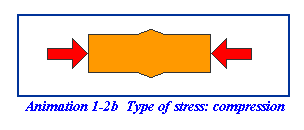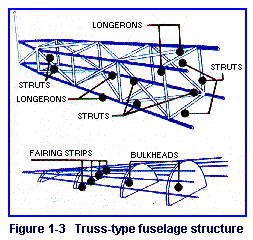 |
|||||
| Home | Research | For Teachers | HISTORY Level 1 Level 2 Level 3 |
PRINCIPLES Level 1 Level 2 Level 3 |
CAREER Level 1 Level 2 Level 3 |
| Gallery | Hot Links | What's New! | |||
| Web Administration and Tools | |||||
 |
|||||
| Home | Research | For Teachers | HISTORY Level 1 Level 2 Level 3 |
PRINCIPLES Level 1 Level 2 Level 3 |
CAREER Level 1 Level 2 Level 3 |
| Gallery | Hot Links | What's New! | |||
| Web Administration and Tools | |||||
![]()
The word fuselage is based on the French word fuseler, which means "to streamline." The fuselage must be strong and streamlined since it must withstand the forces that are created in flight. It houses the flight crew, passengers, and cargo.
Fuselages are classified according to the arrangement of their force-resisting structure. The types of fuselages we will study are the truss and the semimonocoque. Five types of stress act on an aircraft in flight: tension, compression, bending, shear, and torsion. Let's look at each one individually (see animation or figures 1-2, to see the animation press on the icon or the figure).
Tension |
Press |
Tension is the stress which tends to pull things apart. When you try to break a length of rope, you exert a type of stress which is called tension. (see animation or figure 1-2a)
Compression |
Press |

Compression is the opposite of tension. It is the stress which tends to push materials together. When you grasp a football at both ends and push, the ball is subject to compression. The landing gear struts of an aircraft are also subject to compression. (see animation or figure 1-2b)
Bending |
Press |
This type of stress combines tension and compression. You put a bending stress on a bar when you grasp it with both hands and push the ends together or when you bend a paper clip. The wing spars (interior structural members) are subjected to bending while the aircraft is in flight. The lower side of the spar is subjected to tension, while the upper side is subjected to compression. Obviously, some materials will break before they bend and often are unacceptable for aircraft construction. (see animation or figure 1-2c)
Shear stress is caused by forces tending to slip or slide one part of a material in respect to another part. This is the stress that is placed on a piece of wood clamped in a vise and you Chip away at it with a hammer and chisel. This type of stress is also exerted when two pieces of metal, bolted together, are pulled apart by sliding one over the other or when you sharpen a pencil with a knife. The rivets in an aircraft are intended to carry only shear. Bolts, as a rule, carry only shear, but sometimes they carry both shear and tension. (see animation or figure 1-2d)
Torsion |
Press |
Torsion is the stress which tends to distort by twisting. You
produce a torsional force when you tighten a nut on a bolt. The aircraft engine exerts a
torsional force on the crankshaft or turbine axis.
All the members (or major portions) of an aircraft are subjected to one
or more of these stresses. Sometimes a member has alternate stresses, such as compression
one instant and tension the next. Some members can carry only one type of stress. Wire and
cables, for example, normally carry only tension.(see animation or figure 1-2e)
 Since any member is stronger in compression or
tension than in bending, members carry end loads better than side loads. In order to do
this, designers arrange the members in the form of a truss, or rigid framework (see
figure 1-3). In order for a truss to be rigid, it must be composed entirely of triangles.
When the load on a truss acts in one direction, every alternate member carries tension
while the other members carry compression. When the load is reversed, the members which
were carrying compression now are subjected to tension and those which were carrying
tension are under compression. The truss itself consists of a welded tubular steel
structure with longerons (horizontal members) and diagonal braces. These features make it
rigid, strong, and light.
Since any member is stronger in compression or
tension than in bending, members carry end loads better than side loads. In order to do
this, designers arrange the members in the form of a truss, or rigid framework (see
figure 1-3). In order for a truss to be rigid, it must be composed entirely of triangles.
When the load on a truss acts in one direction, every alternate member carries tension
while the other members carry compression. When the load is reversed, the members which
were carrying compression now are subjected to tension and those which were carrying
tension are under compression. The truss itself consists of a welded tubular steel
structure with longerons (horizontal members) and diagonal braces. These features make it
rigid, strong, and light.
The truss is covered with a metal or fabric cover so that less drag will be generated. To produce a smooth surface, the fabric cover is put on fairing strips, which are thin flat strips of wood or metal. These fairing strips run the length of the fuselage in line with the direction of flight.
 The semimonocoque is the most often used
construction for modern, high-performance aircraft. Semimonocoque literally means
half a single shell. Here, internal braces as well as the skin itself carry the stress
(see figure 1-4). The internal braces include longitudinal (lengthwise) members called
stringers and vertical bulkhead.
The semimonocoque is the most often used
construction for modern, high-performance aircraft. Semimonocoque literally means
half a single shell. Here, internal braces as well as the skin itself carry the stress
(see figure 1-4). The internal braces include longitudinal (lengthwise) members called
stringers and vertical bulkhead.
The semimonocoque structure is easier to streamline than the truss structure. Since the skin of the semimonocoque structure must carry much of the fuselage's strength, it will be thicker in some places than at other places. In other words, it will be thicker at those points where the stress on it is the greatest.
Send all comments to ![]() aeromaster@eng.fiu.edu
aeromaster@eng.fiu.edu
© 1995-98 ALLSTAR Network. All rights reserved worldwide.
| Funded in part by | From Civil Air Patrol Educational Materials |
Updated: 23 February, 1999